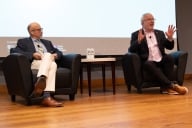You have /5 articles left.
Sign up for a free account or log in.
Since some professors began suggesting that Twitter could be used not just as a recreational lark but as a potentially revolutionary teaching tool, purists and futurists have debated whether academe should swim against the cultural current toward limited, text-based communication, or adapt to it.
Academic libraries increasingly seem to be choosing the latter option. As students raised on text-messaging begin to populate the halls of academe, a number of libraries have begun making their reference librarians reachable not just via e-mail and live chat, but text messages sent from students' mobile devices.
Mosio, a mobile software company based in San Francisco, claims to be the largest provider to libraries trying to meet students on their own turf with its straightforwardly named Text a Librarian program, which is says is used by 250 libraries nationwide, including many colleges libraries. Mosio is hardly alone in the market; LibraryH3lp, Upside Wireless, and the Australian company Altarama Information Systems think their client bases will continue to expand as texting becomes even more pervasive and sophisticated. These services are generally cheap, running at a few hundred dollars per year.
College libraries have offered channels for text-based queries for some time through their Web sites or instant-messenger clients. But with more students using mobile devices rather than personal computers as their gateway to the world of networked communications, some libraries have been compelled to go along.
“Given the typical age of our student population, and everybody walking in the door with a cell phone, it seemed like something we should look into,” says Elizabeth Bagley, library director at Agnes Scott College, in Georgia. Noticing that the number of questions sent to the library’s instant-messaging service had increased by 300 percent between 2006 and 2009, Bagley polled 104 students, faculty, and staff in November asking whether they’d favor the option of submitting such queries via text message; 72 percent said they would, and the library sprung for the Mosio service.
Pamela Sessoms, electronic reference services librarian at the University of North Carolina at Chapel Hill’s Davis Library, also noticed the shift in students’ communication habits, and recently persuaded her institution to spring for a text-messaging integration service from LibraryH3lp, a company owned by her husband that has been deployed at about 60 libraries.
These companies and others offer what they call a “gateway” service, which reroutes texts from students to the library’s instant-message queue or to designated e-mail inboxes. When a librarian responds, the message gets sent to the student’s mobile device. This concept is not terribly new, Sessoms says; for years students have been able to send text messages to their librarians’ instant-messenger accounts. But those solutions required students to start each message with a keyword, which was easily omitted or misspelled, she says. “Gateway” text integrations such as LibraryH3lp have emerged more recently.
Some college libraries have skipped the middleman and simply bought a cell phone dedicated to text queries from students. But that strategy also comes with potential pitfalls. The staff at New York University’s Bobst Library used to monitor a dedicated cell phone, but switched to LibraryH3lp’s gateway service when it became clear that handling queries through a single portal made more sense. “Logistically, it is much easier to coordinate,” says Alexa Pearce, a reference associate at Bobst. A recent article in the journal Library Hi Tech News noted also that some librarians might prefer to type their responses on a computer keyboard, and that, unlike a Web interface, a mobile device can be lost or stolen.
No matter the method, these various experiments suggest that texting, like Twitter, is creeping into academic communication, a prospect some in academe’s old guard might find troubling. How might the quality of students’ research — and research skills — be affected if glib text exchanges supplanted sit-down discussions with research librarians? Between the digitization of collections and the movement toward remote communications with library staff, could it be that students will stop visiting libraries altogether?
Yes, says Joe Murphy, general science librarian and instruction coordinator at Yale University, but this doesn't necessarily portend an apocalypse for learning. The notion that texting implies a less rich exchange between a student and a librarian is false, Murphy says. As people communicate via text more regularly, they learn to do so with more efficiency, he says.
In other words, the way we communicate is not deteriorating so much as it is changing, and academe would do well to change with it. “Any time something changes,” Murphy says, “…we’re gaining and losing with that change. Hopefully what we’re gaining — the ability to stay relevant — is worth what we’re losing. And hopefully what we’re losing is actually just being transformed and not erased.”
And with professors worrying about their students’ research habits in the age of the simple Web searches, college libraries should not be picky about how they are willing to communicate with students, says Sessoms. “I’m just so thrilled that students are using the libraries and the librarians and their expertise,” she says, “instead of just using Google or something like that.”







